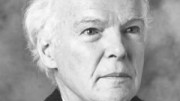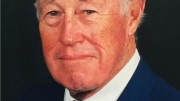Ken Wright had three passions: his family, metallurgy and his pipe.
Born in 1923 in Barwick-in-Elmet village, Yorkshire, England, Ken was the middle child of five brothers. He graduated from the Royal School of Mines in London and started his career in 1945 as a professional engineer with the Mysore Gold Mining Company in India’s Kolar Gold Fields, learning his trade while experiencing the end of the British Raj.
Ken moved on to work for Consolidated Goldfields in South Africa and Tanzania between 1949 and 1953, spending the bulk of his time in gold metallurgy and processing.
For two years he was in charge of a study of the Pugu kaolin deposits near Dar es Salaam. Ken once described a method for testing the material properties of clay that he called the “splat test,” whereby a sample is taken to the top of a three-story building and dropped from a window to the concrete below. Ken had a way of simplifying things. In 1954 he started the first of his two long stints with the Dome Mines Group – a predecessor to Placer Dome, which in turn was subsequently acquired by Barrick Gold. After a brief spell at the Mindamar Metals operation in Cape Breton, Ken moved to Red Lake, Ont., and spent the next nine years as mill superintendent for Campbell Red Lake Mines, where he commissioned a two-stage roaster and wrote a paper on fluid-bed roasting practice.
Leaving Dome in 1965, Ken headed to Ireland to spend the next 14 years in lead-zinc processing with Mogul of Ireland, and later with Bula, during which time he cultivated his love of pubs and good beer and honed his skills as a base-metals metallurgist. Unfortunately, the rich Bula lead-zinc project in County Meath was tied up in litigation and never developed, and Ken’s feasibility work died on the vine.
In 1980, according to Henry Brehaut, then vice-president of operations at Dome Mines, CEO Mac Taschereau broke all human resource protocols by flying to Ireland and hiring Ken as chief metallurgist without Henry’s knowledge. In short order, Henry and Ken were off to South Africa to study carbon-in-pulp (CIP) plants for the up-and-coming Detour Lake gold mine project in northern Ontario.
According to John Goode, previously a vice-president with Kilborn Engineering, Dome approached Kilborn in 1981 with plans to build a 2,500-ton-per-day CIP plant at Detour Lake, which would be the biggest such plant in Canada.
Kilborn’s senior managers were nervous about the proposal and sent John to Dome’s office to convince Ken to reconsider. John recalls being immediately intimidated by Ken’s six-foot-seven frame, not to mention his metallurgical prowess. Kilborn quickly agreed to the idea.
Canada’s first large CIP plant was built and commissioned in 1983 and was a processing success. This was followed by the replacement of the old leach and zinc-precipitation circuit at the Dome mine with a new leach-CIP plant in 1988.
At the same time, Ken supervised grinding-circuit upgrades at the Campbell mine and the Sigma gold mine in Val-d’Or, Que., as well as the commissioning of a new CIP mill at the Dona Lake gold mine near Pickle Lake, Ont. During this time he wrote a paper comparing the flow sheets at the Dome and Detour Lake mines.
Ken Hill, then Dome’s vice-president of mine development, worked with Mr. Wright between 1980 and 1988, and remembers his admirable dedication during the start-ups of Detour Lake and Dona Lake. We also both recall Ken’s penchant for burning perfectly good white dress shirts with ashes from his smoking pipe.
Ken Wright was a man of few words and had a very crusty exterior, but he was a deep thinker and patient teacher who passed on his knowledge to COOs, CEOs and leaders in gold metallurgy and process-plant construction.
He had a healthy disdain for “whiz-kid” wet-behind-the-ears mining executives and computers, although he would eventually buy a computer upon retirement in 1989 for playing bridge and photo-shopping.
During retirement Ken enjoyed his grandchildren, as well as deep-sea fishing, brewing beer and following politics and sports. Unfortunately, Ken chose to leave metallurgy to the young and refused to consult.
Ken passed away of old age on Sept. 23 at his home in Vancouver, 10 days after his eighty-eighth birthday. He was predeceased by his wife of 46 years, Mrs. Joan Wright, née Hodgson, who died in 1995, and is missed by his son Paul, CEO of Eldorado Gold, daughter-in-law Sandra and four grandchildren.
– Based in Acton Ontario, the author is a mining consultant and worked with Ken Wright for nine years at Dome Mines and Placer Dome.




Be the first to comment on "Obituary: Ken Wright: taking a Detour to success"